A fiery tragedy sparks the first national model code for mobile cooking operations
America morphed into a food truck nation in the blink of an eye. Whether they are cruising city streets, parked at festivals, or congregating in a designated food truck corner, food trucks rank among the hottest trends in foodservice today. But inherent to this fast-growing industry are unique fire risks that can pose a significant danger to food truck operators and the people they serve—as well as their business. And until recently, food truck fire safety regulations have strictly been a hodge-podge of local requirements.
In this blog, we reveal the biggest risks posed by and to food trucks and provide an overview of the first National Fire Protection Association (NFPA) model codes aimed at enhancing fire safety in the food truck industry. We also offer some common-sense tips operators can follow to prevent fires and mitigate damage.
In the market for fire protection equipment for food trucks? Check out our online selection of ABC fire extinguishers, and Class K extinguishers that handle grease fires are available on special order; simply call us at +1 (888) 361-6662 or email support@qrfs.com.
The tragic explosion that’s made food trucks safer by spurring food truck fire safety regulations
Since the 2008 recession left out-of-work restauranteurs scrambling for a low-cost way to peddle their fare—and consumers looking for cheaper dining options—food trucks have exploded into a $1 billion industry. The National Food Truck Association estimates that more than 117,000 food truck businesses serve up everything from tacos to cupcakes nationwide, thriving in the midst of the nation’s “foodie” culture and claiming their place as a respectable alternative to brick-and-mortar restaurants.
But as too often is the case, it took a tragedy to crystalize awareness about the alarming fire hazards that food trucks can pose—and the lack of regulation surrounding them.
On July 1, 2014, in the Feltonville neighborhood of Philadelphia, leaking gas from a propane tank on the La Parrillada Chapina food truck ignited. The explosion hurled a fireball 200 feet into the air, shook nearby buildings, and tossed the propane tank 95 feet into a nearby yard (according to an NFPA report). The 42-year-old truck operator and her 17-year-old daughter suffered third-degree burns and died three weeks later. Ten other people were injured, some critically.
It wasn’t the first time a food truck had exploded in public. But this time, the horrific event was captured by a nearby surveillance camera. The video went viral across the Internet and media outlets demanded answers to the question on everyone’s lips: Are food trucks safe?
Watch this video of the explosion that triggered the first NFPA fire safety standards for food trucks:
A hodge-podge of local food truck fire safety regulations prompts the call for a consistent national food truck code
Within days, NFPA leaders had proclaimed the need for national food truck fire safety requirements. The International Fire Marshals Association (IFMA) convened a task force to create a new chapter for the 2017 edition of NFPA 96: Ventilation Control and Fire Protection of Commercial Cooking Operations that specifically addressed food truck safety. Its language was also incorporated into a new section aimed at “mobile and temporary cooking operations” added to the 2018 edition of NFPA 1: Fire Code.
Previously, with no national code or standard to address the issues, every city had simply created whatever food truck regulations it thought best—and many didn’t even realize there was a problem. For instance, at the time of the Philadelphia explosion, the NFPA Journal recounts that Chicago imposed rigorous oversight on food truck operators that required them to submit fire protection plans, pass a lengthy inspection, and pass a fire safety class. In contrast, Indiana state laws banned fire departments from inspecting vehicles—and food trucks were lumped into that category.
With the number of different regulations rivaling the number of food trucks on the road, confusion over the best fire safety practices ran rampant throughout the industry. Truck operators needed to grasp a hodge-podge of rules about how to prepare and serve food, where to park, what permits were needed, and how often inspections were required. And the instant they rolled across city lines, everything could change.
In many jurisdictions, food trucks fell into a gray area of fire safety regulations that made the situation even cloudier. Requirements for brick-and-mortar restaurants didn’t fit the size and structure of a mobile kitchen, and food trucks’ mobility also prevented them from fitting the definition of temporary structures covered by fire codes, such as kitchens operating under tents at events.
Even worse, after the Philadelphia explosion, some nervous cities tried to enforce rules that didn’t correspond to a defined regulation on their books—a questionable practice that made it extremely difficult for food truck operators to know what they needed to do to comply.

Food truck fire safety risks
Like any foodservice establishment, food trucks brim with potential fire hazards that can cause a fire to quickly spiral out of control: open flames, hot equipment, propane tanks, gas generators, electrical connections, cooking oils, splattered grease, cleaning chemicals, paper products, gasoline or diesel fuel, and engine oil. But unlike brick-and-mortar restaurants, customers at the counter stand uncomfortably close to fire hazards in the kitchen, making it even more important for food truck operators to take extra precautions.
Explosions like the tragedy in Philadelphia may be uncommon, but they do occur. In 2011, two workers were burned when a propane tank on a popular New York City food truck exploded after a car accident. In 2014, three people were injured when a gas leak triggered a food truck explosion at a high school football game in Fresno, Calif.
A year later, 20 homes were damaged when a food truck exploded in a Lakeview, Minn., driveway—a blast so strong that it shook art off walls and was heard six miles away. And just days ago, a popular food truck owner known for serving up fried fish and shrimp dishes was severely burned when a propane tank exploded inside his truck at a downtown Detroit event.
NFPA reported an average of 540 vehicle fires every year between 2007 and 2011 where propane was the first material ignited, causing an annual average of three deaths and $8 million in property damage. While it’s unclear how many of those fires involve food trucks, it underscores a potential danger that shouldn’t be ignored.
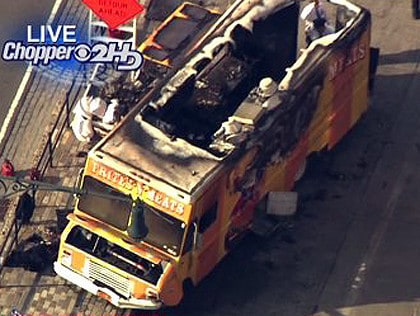
Most food truck chefs rely on either gas or electricity to cook. Fires can spark from the stove, oven, and bubbling fryer, but it is fuel sources that carry the greatest potential for inflicting destruction and casualties.
Let’s examine the biggest risks:
Propane tanks
Propane poses the most significant risk of fire in a food truck. NFPA asserts that 68 percent of food truck fires are related to leaks or structural failures in propane tanks. Propane explosions were behind almost every food truck fire involving injuries and deaths in recent years.
Here’s the thing: while cooking with propane is generally considered safe, just a small, 20-pound propane cylinder attached to a backyard grill contains the explosive power of 170 sticks of dynamite – generating more than 425,000 BTUs (British Thermal Units) of energy.
Food trucks can carry 100-pound propane cylinders capable of exploding with more than 2.5 million BTUs. The very nature of food truck use amplifies the risk, as trucks are commonly parked at events or lined up along streets where large numbers of people congregate, cramming an enormous explosive potential into a small, heavily populated space. In fact, the FDNY (New York City’s fire department) considers food trucks a potential terrorist threat due to the explosive power of their propane tanks.
Food trucks are constantly on the move, driving over bumpy roads and potholes that can jostle propane tanks—loosening connections and fittings and causing other structural damage. Failing to properly tighten fittings when tanks are swapped out can also cause leaks.
Since propane is heavier than air, an undetected leak on a tank inside a truck tends to pool near the floor. In a truck saturated with cooking smells, people may not realize that they are standing in a pocket of propane gas. And a single spark from the oven or stove can ignite the gas.
Carrying propane tanks on the outside of trucks decreases the risk posed by leaks—but increases the risk of tanks exploding on impact in even minor collisions.
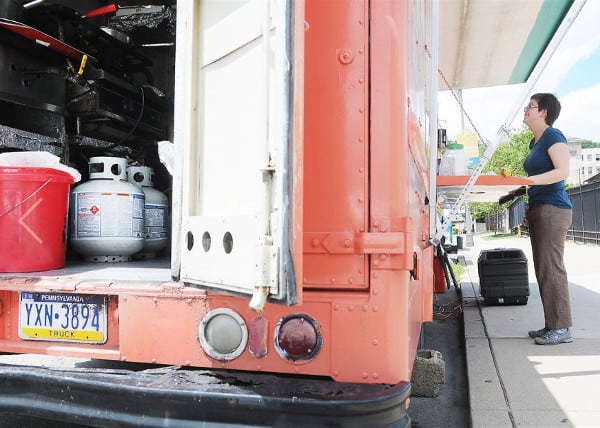
Cooking without the right fire suppression systems
NFPA states that cooking equipment causes 61 percent of fires in eating and drinking establishments, and fire codes have long required hood suppression systems over ovens, burners, grills, and fryers in commercial kitchens. The 2018 edition of NFPA 1 (50.7.3.3) emphasizes that food trucks are not exempt from being “protected by an approved hood fire suppression system or other approved means of extinguishment in the event of fire.”
However, automatic fire suppression systems are often absent in older food trucks or vehicles converted into mobile kitchens. Most food truck operators carry portable fire extinguishers, but many don’t realize that they need two types to effectively extinguish the types of fires they are likely to face: a Class K extinguisher for suppressing grease, fat, or cooking oil fires and an ABC extinguisher for putting out fires involving paper products or other types of fires.
Portable generators
Portable generators used to run electricity to a food truck can also create fire risks. Generally, the danger is greatest in older food trucks or vehicles converted into mobile kitchens rather than newer food trucks specifically built for cooking operations.
Here’s why: without proper venting, trucks can fill with flammable (and otherwise dangerous) carbon monoxide gas created by the generator or electrical system. Many cramped food truck spaces also do not include places to properly store the fuel required to run the generator safely away from ignition sources.
NFPA 1 and 96 cook up model food truck fire safety regulations
At the time of the Philadelphia explosion, NFPA 1, NFPA 96, NFPA 58: Liquefied Petroleum Gas Code, and NFPA 1192: Standard on Recreational Vehicles contained requirements that addressed some fire safety hazards associated with food trucks. But there was no code specifically designed to provide consistent minimum safety requirements for mobile cooking operations—and many safety concerns were omitted.
Many authorities having jurisdiction (AHJs) expressed interest in adopting food truck fire safety regulations but lacked the expertise to create regulations on their own. NFPA leaders concluded that a national standard that is easy to adopt would go a long way toward increasing the number of communities with comprehensive food truck safety regulations.
The IFMA task force responded with 16 pages of proposed code that was largely incorporated into the latest editions of NFPA 96 (Annex B) and NFPA 1 (Section 50.7). The new additions impact many fire safety aspects of food trucks, including requirements for installation, testing, maintenance, portable fire extinguishers, proximity to nearby structures, communication with emergency personnel, emergency response training, installation of containers and storage, and the use and transport of LP (liquified petroleum, or propane) gas.
IFMA also defined mobile or temporary cooking as: “Any cooking facility, apparatus or equipment, being operated on a one-time or interim basis, or for less than 90 days in the same location, other than at a fixed location, building or structure which has been inspected and permitted under another section of this code, regulation or statute, inclusive of self-propelled trucks and vehicles, trailered units, pushcarts, equipment located under cover of awnings, canopies or pop-up tents, or other structures for which a building permit has not been issued.”
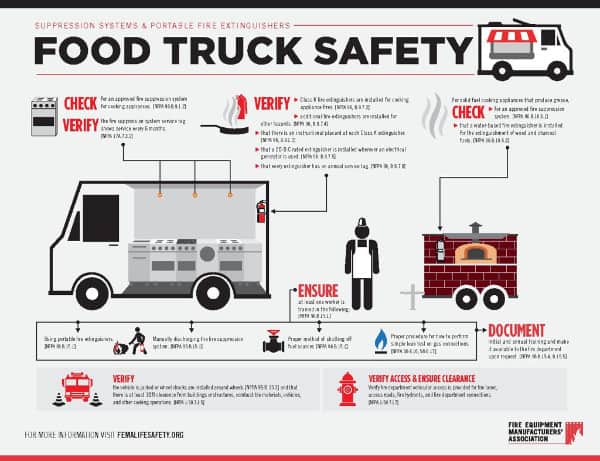
Changes to NFPA 96
NFPA 96 covers the minimum preventive and operative fire safety requirements related to the design, installation, operation, inspection, and maintenance of public and private commercial cooking operations. The new Annex B chapter adds extensive requirements for food trucks that cover clearance, exhaust hoods, exhaust duct systems, fire extinguishing equipment, employee training, solid fuel cooking, and communication protocols. It also covers procedures for inspection, testing, and maintenance of cooking equipment.
For instance, new requirements surrounding the detection of LP-Gas (propane) system leaks mandate:
From the 2017 edition of NFPA 96
B.19.2.1 All recreational vehicles equipped with a propane appliance and an electrical system shall be equipped with a propane detector listed and marked on the device as being suitable for use in the vehicles under the requirements of ANSI/UL 1484, Standard for Residential Gas Detectors, and installed according to the terms of its listing (1192:6.3.3.1)
B.19.2.2 The LP-Gas leak detection system shall be tested monthly.
B.19.2.3 LP-Gas systems shall be inspected prior to each use.
B.19.2.4 LP-Gas leak detection testing shall be performed every time a new LP-Gas connection is made or an LP-Gas cylinder is changed out.
B.19.2.5 LP-Gas leak detection testing shall be documented and the documentation shall be held in the mobile or temporary unit and made available to the AHJ upon request.
NFPA 96 fashioned its mobile and temporary cooking operations chapter as a “normative annex” so that AHJs that don’t currently enforce NFPA 96 could choose to implement it without having to adopt the rest of the standard. Although annexes may be written in mandatory language, they do not function as code requirements unless specifically adopted by an AHJ.
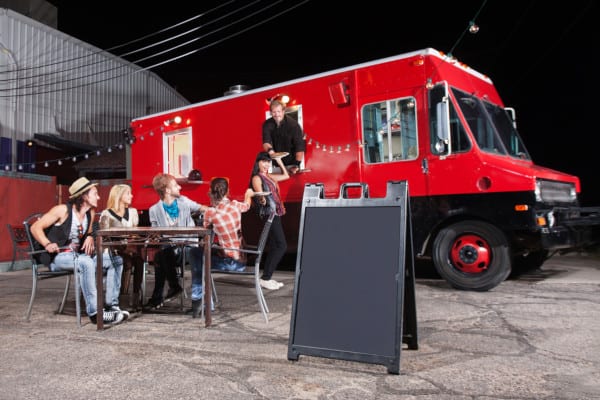
Changes to NFPA 1
Section 50.7 of NFPA 1, on the other hand, does stand as a mandated requirement of the national fire code. It stems from the new provisions added to NFPA 96, but also expands upon the other code with several unique requirements. Highlights of the new section in the 2018 edition of NFPA 1 include:
Permit requirements
50.7.1.2 Where required by the AHJ, permits shall be required for the location, design, construction and operation of mobile and temporary cooking operations.
Vehicle safety
50.7.1.3 Wheel chocks shall be used to prevent mobile and temporary cooking units from moving.
Separating food trucks for safety
50.7.1.5 Mobile or temporary cooking operations shall be separated from buildings or structures, combustible materials, vehicles, and other cooking operations by a minimum of 10 ft (3 m).
Banning food trucks from public tents
50.7.1.6.1 Mobile or temporary cooking shall not take place within tents occupied by the public.
50.7.1.6.2 Tents shall comply with Chapter 25.
Seating prohibitions
50.7.1.6.3 Seating for the public shall not be located within any mobile or temporary cooking vehicle.
Ensuring fire department access
50.7.1.7 Mobile or temporary cooking operations shall not block fire department access roads, fire lanes, fire hydrants, or other fire protection devices and equipment.
Communication protocols in emergencies
50.7.1.8.1 An approved method of communication to emergency personnel shall be accessible to all employees.
50.7.1.8.2 The address of the current operational location shall be posted and accessible to all employees.
Training employees in emergency response procedures
50.7.1.9.1* Prior to performing mobile or temporary cooking operations, workers shall be trained in emergency response procedures, including the following:
(1) Proper use of portable fire extinguishers and extinguishing systems
(2) Proper method of shutting off fuel sources
(3) Proper procedure for notifying the local fire department
(4) Proper refueling
(5) How to perform leak detection
(6) Fuel properties
50.7.1.9.2 Refresher training shall be provided every year.
50.7.1.9.3 Initial and refresher training shall be documented and made available to the AHJ on request.
General precautions for fryers
50.7.2.4.8.1 All fat fryers shall have a lid over the oil vat that can be secured to prevent the spillage of cooking oil during transit. This lid shall be secured at all times when the vehicle is in motion.
For full requirements, please access a copy of NFPA 1.
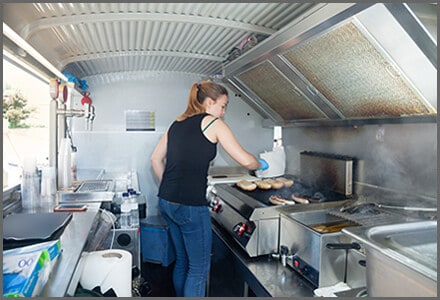
To make its new requirements easily digestible by the food truck industry, NFPA created a free downloadable fact sheet that maps out specific areas of a truck with corresponding tips and information on proper usage and care.
10 common-sense tips for enhancing fire safety on food trucks
Adding food truck fire safety requirements to the NFPA model code makes adoption of enforceable code easier for local governments and fosters public safety. But if regulations aren’t in place within a jurisdiction, there are many commonsense steps food truck operators can take to prevent and mitigate fires:
- Schedule regular inspections and maintenance of electrical equipment and keep an eye out for hazards like frayed wires or combustible items near power sources.
- Train employees to never throw water on a grease fire. It can cause the grease to splatter and spread, making the fire worse. Class K fire extinguishers are best for fighting grease fires. Food trucks need two types of fire extinguishers: Class K extinguishers for fighting grease fires and Class ABC extinguishers for putting out standard fires, such as those involving paper products.
- Follow NFPA regulations for hydrostatically testing fire extinguishers and propane tanks. Make sure the equipment is stamped with the testing date to ensure it remains in proper working order.
- Regularly inspect kitchen exhaust systems within the truck for grease build-up. The frequency of inspections is defined in NFPA 96 (Annex B), based on the volume and type of cooking.
- Clean up grease at least once a day, concentrating on walls, work surfaces, ranges, fryers, broilers, grills, convection ovens, vents, and filters. Pay extra attention to exhaust hoods, where grease buildup can restrict air flow. NFPA 96 (Annex B) provides extensive instructions for cleaning food truck exhaust systems.
- Keep the food truck as tidy as possible to reduce fire hazards. Keep paper products, linens, boxes, and food away from heat and cooking sources. Properly dispose of soiled rags, trash, cardboard boxes, and wooden pallets at least once a day.
- Remove ashes from wood- and charcoal-burning ovens at least once a day. NFPA 96 (Annex B) provides extensive guidance for ash removal.
- At least one employee on every shift should know how to shut off propane and electrical power in case of an emergency. Also designate one worker per shift to act as an evacuation manager with duties that include calling 911, determining when an evacuation is necessary, ensuring that everyone exits the truck safely, and leading customers a safe distance away. Along those lines, ensure that everyone on your staff knows the location of all exits on the truck.
- Store flammable liquids in their original containers or other puncture-resistant, tightly sealed vessels. Food truck kitchens are small, but operators must do their best to store these liquids in well-ventilated areas away from combustible supplies, food, food preparation areas, or sources of flames.
- Use chemical solutions in well-ventilated areas and immediately clean up any spills. Never mix chemicals unless instructed by the manufacturer’s directions.
New NFPA model code helps standardize food truck fire safety regulations—so operators hit the road safely
Delighting the public with high-quality, delicious fare is the priority of food truck operators. But keeping themselves, their workers, and their patrons safe remains an ongoing concern due to the fire hazards that can exist on their trucks. Fortunately, new NFPA regulations have reached the intersection of food and wheels, creating awareness of the risks food operators face and providing a single source they can turn to for guidance on hitting the road safely.
In the market for fire protection equipment for food trucks? Check out our selection of ABC dry chemical fire extinguishers.
We also carry wet chemical, 1-A: K-rated extinguishers that handle high-temperature fires involving cooking oils and grease. These are available on special order: call us at +1 (888) 361-6662 or email support@qrfs.com.
This blog was originally posted at blog.qrfs.com. Check us out at Facebook.com/QuickResponseFireSupply or on Twitter @QuickResponseFS.



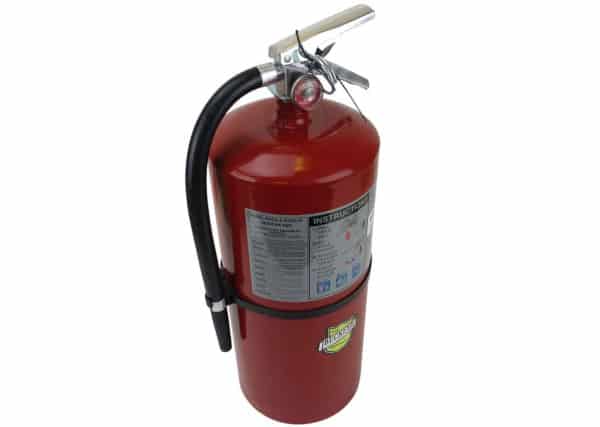
I also agree with you. The food truck business is a fast-growing industry that is unique fire risks. For this reason, food truck fire safety regulations have strictly been a hodge-podge of local requirements.
We need a do it yourself class k and ABC auto/manual with sprinkler heads for mobile food truck
Thank you
Shawn — Thank you for reaching out. We will have someone from our QRFS Customer Support Team contact you, and you can also email them any requests to get faster service!
Could you also have that information sent to me? Also I didn’t see information here about 2nd form of egress. Are there any regulations or requirements for that?
Renee — We’re not sure what info you are referring to. If it’s the customer service request above (from 2021), customer service could help the individual with fire extinguishers, but we no longer offer them. Regarding egress rules, you can try our Ask a Fire Pro service, provide information about your specific situation, and run specific questions by a fire pro if you would like. Thanks for reading!
Can we set up a food truck hall inside vacant 10,000 auto and tire service center with tall ceilings?
Room for about 20 food trucks spaced apart, drive in, park and open for events rain or shine.
Is this allowed?
Expo — For specific code questions like this, you can try our Ask a Fire Pro service. Click the link to submit your question with some information about your building, and a fire protection professional will provide an answer based on best practices, standards, and codes. Our pros include AHJs, contractors, engineers, and code experts with 150+ years of combined experience!
In mississippi, is a fire suppression system required for a food trailor? Or is a k rated and abc rated extinguishers applicable?
Mark — For code questions like this, you can try our Ask a Fire Pro service. Click the link to submit your question with some information about your building and system, and a fire protection professional will provide an answer based on best practices, standards, and codes. Our pros include AHJs, contractors, engineers, and code experts with 150+ years of combined experience!
Good morning Mark did you get the answer to your question because I need to know also
Where does the gas line needs to be located on a food truck trailer underneath or inside the trailer?
Ron — please consult your local authority having jurisdiction (AHJ; e.g., the fire marshal) to determine the answer to this question. Thanks for reading!
What about parking food truck too close to fuel drops at the gas stations? Is there a certain # of feet/yards that is permissible?
Erica —
There have been significant standards updates since this blog was published; NFPA 96 (now in the 2024 edition) now incorporates food truck rules in “Chapter 17: Additional Requirements for Mobile and Temporary Cooking Operations.” Regarding parking distance from gas stations, the only explicit reference to all buildings we see is:
NFPA 1 (2021 edition) has a similar section:
In addition, there are several entries on refueling protocols in NFPA 96 (also reflected in NFPA 1), including:
Otherwise:
Note, however, that this answer is not definitive; we haven’t done a recent deep dive into the latest standard, and other standards or codes like NFPA 1 may apply. In addition, note the words “or as prescribed by the AHJ” in the NFPA 96 section on parking distance to all structures. So, your local authorities may have specific rules for parking distance from all structures or gas stations in particular.
For a definitive answer, you should contact your local authority having jurisdiction and NFPA (here is the latter’s contact info). Thanks for reading!
Does a food trailer require two means of egress?
Rick — We’re unsure of the answer; we’d have to do some research to check if egress requirements are within NFPA and other standards and codes governing food trailers. However, the term egress is not mentioned within Chapter 4 of Chapter 17 of NFPA 96, nor in this NFPA safety checklist. That said, again, we do not know offhand. We advise you to contact your local authority having jurisdiction and ask them about means of egress requirements—those will be most relevant vs. model codes and standards anyway. Thanks for reading!
Can I cook on the back of a food trailer without having a fire suppression? I have a class k exingusher. The back porch is well ventilated with a roof no cooking is done inside the trailer
Roger — You should contact your local authority having jurisdiction to verify the rules in your area. Thanks for reading.
We just built a food truck with a wood burning stone oven.
we’ve heard we are not aloud to burn wood in a food truck in Chicago.
Do you know if that’s true?
I’ve seen 3 other food trucks with wood burning ovens.
Kelly — Unfortunately, we can’t keep track of all the food truck fire codes and regulations in every jurisdiction (vs. the NFPA guidance). Your best bet is to contact your local (Chicago) authority having jurisdiction. Chicago’s Fire Prevention Bureau is a good place to contact. We hope that helps!